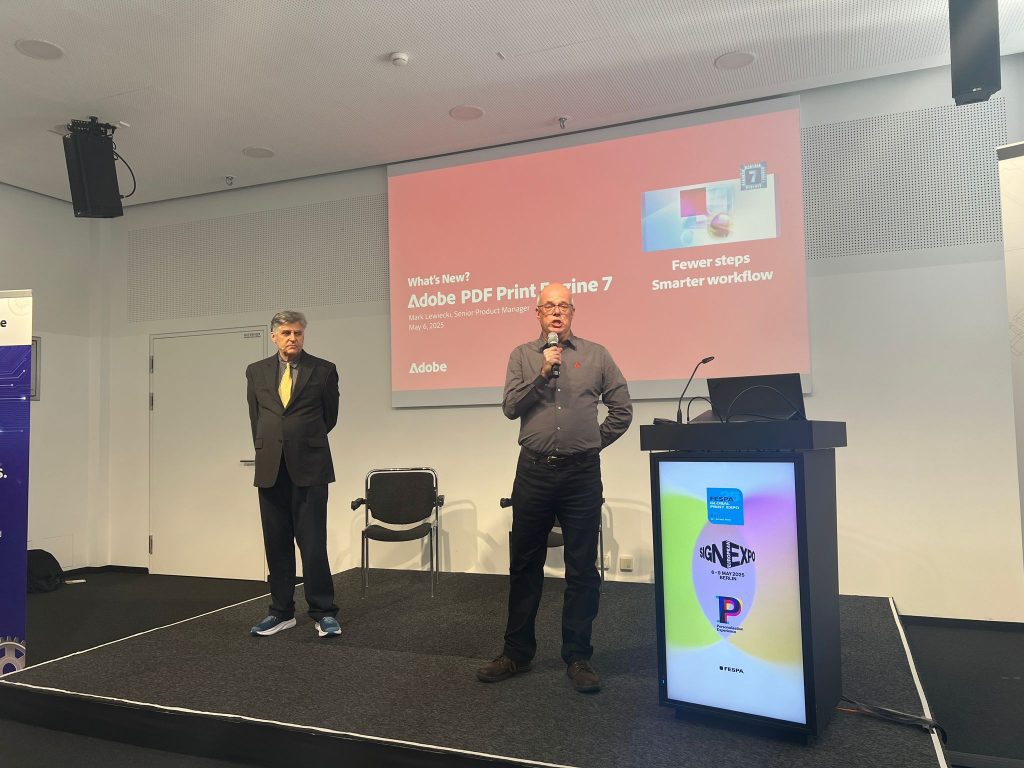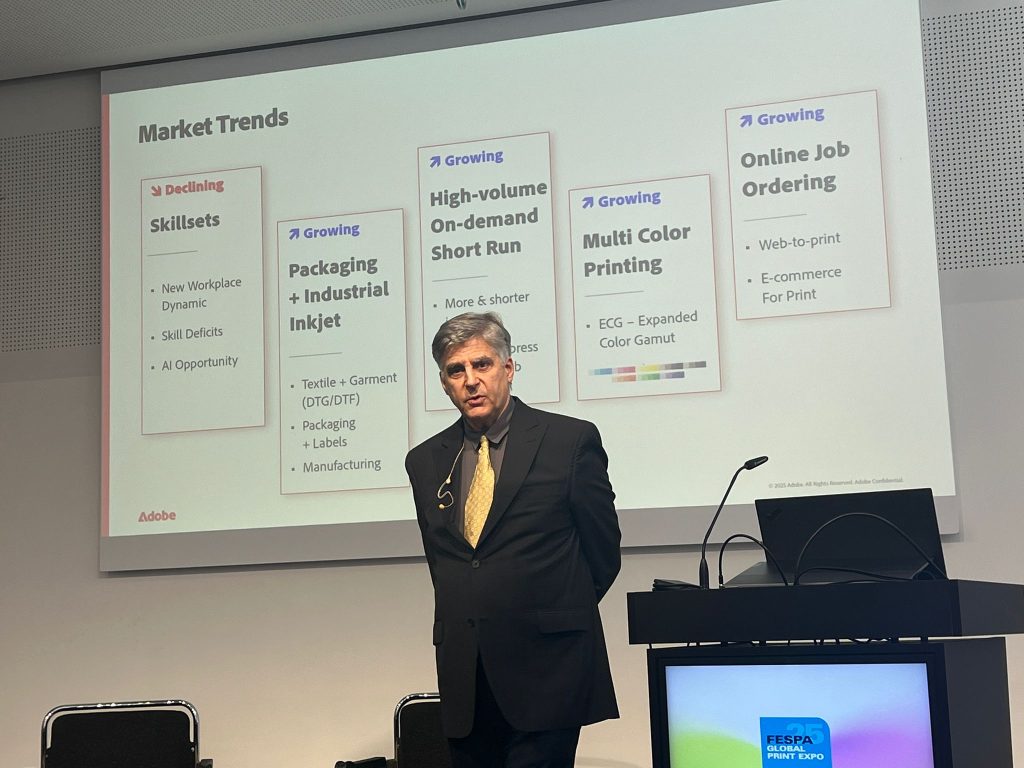Adobe PDF Print Engine 7 accelerates productivity and automation by embedding prepress intelligence inside the RIP (Raster Image Processor)
Adobe today announced version 7 of Adobe PDF Print Engine. The new release includes several rendering innovations that have already been welcomed by leading Print OEMs and RIP solution providers who integrate Adobe technology into their prepress products.

PDF Print Engine is the industry’s performance leader, and the new features can leverage the scalability of the Mercury RIP Architecture.
Fewer steps, smarter workflows
PDF Print Engine 7 integrates new functions into the rendering pipeline (inside the RIP), reducing the need for specialized skill sets, and eliminating separate prepress operations. Combining pre-RIP functions with in-RIP rendering results in fewer manual interactions, more automation, and faster production. These new capabilities will accelerate high-volume custom printing, web-to-print job submission, direct-to-garment printing, and a range of industrial and packaging workflows. Thirty years after the dawn of the PDF era, version 7 of the Print Engine demonstrates Adobe’s ongoing commitment to delivering the latest advances in imaging science to commercial printers, packaging converters, and manufacturers worldwide.
What’s new in Adobe PDF Print Engine 7
- in-RIP multicolor transparency blending. An industry first, this feature overcomes the challenging technical hurdles of transparency blending for ECG print jobs (Expanded Color Gamut). It blends transparency and separates plates for presses with CMYK plus any combination of inks, for example, Orange and/or Green and/or Violet (CMYK+OGV). Jobs that contain one or more transparent elements will take full advantage of the press gamut, enabling all images and graphics in the job to appear more vivid and attention-getting. This breakthrough feature will help to accelerate the adoption of multicolor ECG printing for digital, offset, and flexo production.
- in-RIP merging of variable product data. Consumer Package Goods (CPG) manufacturers need connected packaging to fight counterfeiting and track distribution logistics. This new feature will help to accelerate adoption of product authentication and to streamline production of simple direct mail. Performing real-time functions inside the RIP – the merging of dynamic content such as serial numbers/barcodes onto a static PDF template, while simultaneously stepping the resulting unique pieces – eliminates up to two sets of prepress activities, significantly reducing processing time while removing the need to generate and manage intermediate files.
- in-RIP rendering of Adobe Photoshop and Illustrator job files. Designers who use Illustrator and Photoshop sometimes submit jobs in native format instead of PDF. Most commercial printers accept and welcome such jobs, often from web-to-print channels. Now, prepress operations can eliminate the manual steps of opening the job in the design application and converting it to PDF. Built using proprietary technologies, the new capability will ensure Adobe quality reproduction of every job.
- in-RIP bleed generation. For jobs that will be trimmed but were submitted with graphics that stop at the trimline, a bleed can be generated as part of the rendering stage, eliminating the need for interactive pre-RIP remedies.
- in-RIP cutline expansion. For jobs that will be printed on a large format press, and finished on a cutting table, the perimeter cutline can be automatically modified to account for the thickness, angle, and pressure of the cutting blade/rotor/laser as well as the flexibility of the substrate, eliminating the need for manual preparation.
- in-RIP white mask generation for printing on metallic substrates. Designers often define a spot color swatch to represent metallic-looking elements in a job, even when the entire printing surface is metallic. The new feature builds on the white ink capabilities of Print Engine 6 to automatically generate a white ink mask from the metallic spot color plate. It will minimize waste/costs by reducing the coverage area and quantity of expensive white ink. The feature eliminates the need to perform this function post-rendering.
- New performance and scalability enhancements. Building on the robust and scalable architecture of PDF Print Engine, version 7 introduces new enhancements that take full advantage of available hardware (including SSDs) to boost the speed of caching, image resampling operations, and multithreaded trapping.
Availability
The beta release of PDF Print Engine 7 was made available to Adobe print RIP SDK licensing partners in April, and the final Gold Master edition will be distributed to them in August. Adobe expects that industry-leading OEMs and RIP vendors will begin to release products powered by version 7 in 2026.

New technology preview – Adobe Print Services
A pre-release preview of the new Adobe Print Services platform was demonstrated today at FESPA in Berlin. This new AI-powered platform will automate pre-RIP conversion tasks. Integrating Adobe Print Services into the prepress workflow will enhance the value of PDF Print Engine by performing a range of Correction, Enhancement, and Optimization services in the following areas:
- AI & Machine Learning – a suite of AI & ML powered capabilities that up-sample images with insufficient resolution, detect text that has been outlined, and minimize processing overhead through intelligent self-configuration.
- Adobe libraries – Open architecture for easier access to core capabilities
- Bleed generation – Complements the in-RIP bleed capabilities of Print Engine 7 by extending complex patterns, diagonal lines, and photographs, using Adobe proprietary Content-Aware fill technology.
- Variable Data Printing – Accelerates prepress processing and rendering of direct mail and customer correspondence job.
Adobe Print Services will be made available to Adobe print partners in the near future.
“Adobe is excited to bring the powerful innovations in version 7 of the PDF Print Engine to our solution partners, and the entire print industry,” said Naveen Goel, Vice President of Products and General Manager of the Adobe print business. “Printers need to process more jobs in the same amount of time. Commercial printers, packaging converters, textile/garment printers, and product manufacturers will realize the time-saving and cost-saving benefits of the Adobe Print Services platform, combined with the new features in Print Engine 7. Prepress steps can be eliminated through in-RIP integration with PDF Print Engine 7 or automated with Adobe Print Services. These Adobe innovations will sharpen a printer’s competitive edge and help to expand the business horizon by capitalizing on opportunities in new industry segments.”
